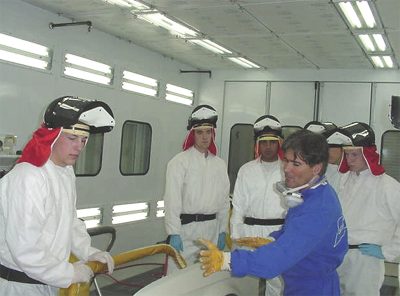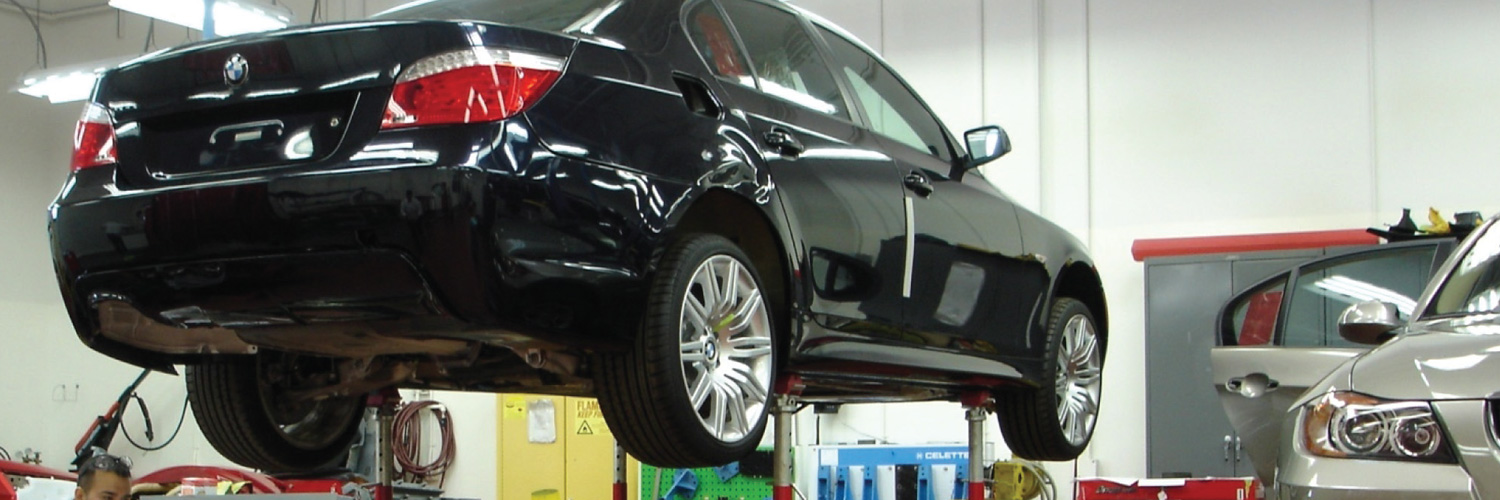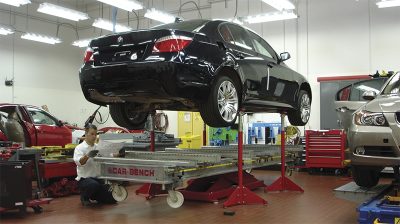
The commitment to superior collision expertise is no idle claim. Planning, preparation, execution, and a thirst for continual improvement are essential ingredients for meeting that commitment. The Body & Paint Service Technician Education Program (STEP) developed by BMW of North America LLC (BMW) helps guide collision technicians to the lofty goal.
STEP is intended to help achieve several key objectives. These include:
- Providing BMW dealer network and dealer-associated independent body shops with highly skilled technicians.
- Using state-of-the-art training facilities to enable technicians to learn, practice, and refine BMW-specific skills and repair procedures.
- Enabling technicians to learn current and future repair competencies and processes.
- Supporting BMW’s Certified Collision Repair Center (CCRC) program.
Not only does STEP work for BMW, it is also the best in the industry and is recognized as such by independent collision industry organizations, equipment and tools makers, and technicians who have completed it. Most importantly, it delivers the level of expertise that customers expect and deserve.

Organizations that collision repairers rely on respect STEP

the bimmer pub attends many key collision industry events, hosted by automakers, the Society of Automotive Engineers (SAE), the Inter-Industry Conference on Auto Collision Repair (I-CAR), and other industry associations and groups. At these get-togethers, the praise, respect and high regard that STEP receives from others impresses us. It’s success is a story worth telling.
Consider the Equipment and Tool Institute (www.etools.org), which has a long association with BMW. ETI members include the manufacturers that develop and build the tools, equipment and other products required by automakers to perform collision and mechanical repair, as well as third-party aftermarket information and software providers. Note that the BMW-ETI connection is relevant, because BMW requires a number of specific products from ETI members be used by its CCRCs; for other body shops not in that network, those products are recommended.
ETI also hosts three annual industry events at which automakers, including BMW, meet and share information (e.g. scan tool data, wiring diagrams), emerging automotive technology that will require the development of new tools or equipment (e.g. carbon fiber, active safety, and electrified systems) and relevant collision repair/replacement procedures (e.g. specialized welding, new lightweight metals). Of note, BMW has even presented STEP training to industry attendees at these events.
BMW cooperates with all industry segments to improve reparability
After attending a STEP training session titled Bonding and Adhesives, we were prompted to speak with Tim Morgan, who serves ETI as chairman of the Collision Repair Group.
“The new designs, evolving material content of vehicles, and how they are built are making collision repair more difficult,†Morgan said. “The biggest challenge I see in the industry today is getting the correct education to collision technicians — making them understand what the new vehicle content and repair processes are. Without authentic service information, training and the right equipment or tools, a safe, complete repair cannot be performed,â€
“BMW is unique in that it provides collision repair training to technicians as well as suppliers like ETI members,†he added. “Like every other segment of the collision industry, equipment and tool manufacturers also have a responsibility to stay abreast of emerging automotive technologies, handling new materials, or employing new repair procedures. That’s a major reason we are involved with BMW and its Body & Paint STEP training.â€
More recently, at an I-CAR event, Technical Director Jason Bartanen described how OEM collision training varies across the industry. “How collision training is delivered to technicians differs from one automaker to another. Most OEMs require all training be delivered through a specific mix of I-CAR and OEM-approved providers. Some require all training to be provided by I-CAR. BMW is unique because it provides all collision (and mechanical) training to technicians.
“I-CAR works with all automakers,†he continued. “It is clear to us that the BMW STEP collision training model is one that other automakers would do well to emulate.†But here’s the kicker: “Compared to other automakers, BMW STEP collision training is second to none.â€
STEP empowers technicians and facilities to seize expertise
It was at a recent ETI/I-CAR sponsored forum titled Collision Repair in the Aftermarket, that we first met Tom Brizuela, Body & Paint STEP technical team leader at BMW’s Oxnard, Calif., training center. Brizuela was actively involved in developing the Body & Paint STEP curriculum; his expertise and experience intrigued us. We met with him briefly after the forum, and later visited with him after he returned to the training center.
“BMW Body & Paint STEP training is open to dealer technicians and independent technicians recommended by a BMW dealership,†Brizuela said. Although not within the scope of this article, he added that STEP also is available to aspiring technicians in bona fide automotive education programs that meet NATEF/AYES requirements. “The same STEP training is provided to all participants, whether they are independents, dealers, or aspiring techniciansâ€
“Every aspect of BMW-specific collision repair is learned and performed under the guidance of expert instructors.†noted Brizuela, “In addition, each of the centers is fully tooled and equipped to the same standards that BMW requires of its Certified Collision Repair Centers (CCRCs). This allows us to prepare technicians to work in any collision facility — dealer or aftermarket — that is prepared to properly repair BMW vehicles.â€
Qualifying technicians who complete the Body & Paint STEP curriculum will have the following BMW-specific core collision repair competencies:
- Use of BMW Integrated Service Technical Application (ISTA)
- Removal and installation of body components.
- Structural and non-structural body repair.
- Welding techniques.
- Bonding and riveting procedures.
- Aluminum repair.
- Specialized BMW repair procedures.
- Paint preparation and application.
- Diagnosis and estimating.
- Entry-level paintless dent repair.
- Polishing and detailing.
In addition, Brizuela notes that the elite graduates from the foundation STEP Level I training are eligible to be selected to attend the brand-new Body & Paint STEP Level II program that BMW has just developed and deployed.
Making the grade

Brizuela said that it is important that collision professionals — whether dealer or independent — understand what is required to become a BMW CCRC. “BMW insists on rigorous standards when it comes to the repair of the vehicles it builds. This requires substantial investment and commitment to ongoing technician training, specialized tool and equipment technology, paint systems, materials, and other BMW criteria.â€
“BMW customers deserve every assurance that, whether service or collision repairs are performed, the competency of the technicians that work on their cars and quality of the materials and parts used is unparalleled and keeps pace with change. To retain their CCRC designation, BMW dealers must undergo an annual audit, similar to how hospitals and other standards-based organizations and businesses are reviewed.â€
The auditing firm retained by BMW is required to:
- Conduct onsite inspections of the facility’s equipment, tools, paint, material and other physical resources.
- Review staff training requirements, repair procedures and processes.
- Help the facility update its action plan.
- Report observations and results to BMW that then serve as the basis for continued certification.

The audit ensures compliance with the expectations of regulators and the automaker. It identifies and schedules BMW-credentialed continuing education and training to ensure that technician competencies keep pace with ever-increasing vehicle complexity. It also gives substance to the level of collision expertise that BMW and its customers expect from a CCRC.
“Of the 350 BMW dealerships nationwide, just 70 are BMW dealer-owned CCRCs,†Brizuela said, based on his last review of available data. “Clearly, there is a lot of collision repair being done by independent aftermarket facilities. BMW recognizes this market reality by providing training across the technician and collision facility spectrum. For example, of the Body & Paint STEP participants who were already existing technicians, approximately 75 percent of attendees were from BMW dealers, while 25 percent were from independent shops.â€
“The independent collision shops that some BMW dealers choose to work with need to deliver the same capabilities and quality of repair as a CCRC. That’s why dealers that don’t own their own bodyshop will only work with certain independent shops. It is also why they can confidently recommend certain independent collision technicians from those independent collision shops to attend Body & Paint STEP and other BMW training.â€
What do collision facilities say?
Bodyworks by Concours is a BMW CCCR located in Milwaukee, Wis. Tom Gillespie, manager of the collision facility, says that when he was hired by Bodyworks, he was tasked with transitioning Bodyworks to a BMW CCRC facility. Having worked previously for the first BMW dealer to become a CCRC, he knew the path ahead.
“Our technicians work on high-end, technology-enhanced BMW vehicles every day,†he said. “Before a new BMW model even hits showroom floors, our BMW-trained technicians must know how to take it apart, make body adjustments to it, and be able to provide collision-related repairs to that vehicle. In addition, these complex vehicles must be diagnosed and reprogrammed after every collision.â€
He cited BMW CCRC criteria —tooling and equipping the body shop to CCRC standards, the use of BMW Clear System brand of waterborne paint and refinishing processes, and ongoing BMW-credentialed training for its working and entry-level technicians— as enablers for Bodyworks’ successful transition.
Moritz Body Shop is located in Arlington, Texas. Owned by Moritz BMW/Mini, the bodyshop is not a BMW CCRC. According to the bodyshop’s manager, Perry Newton, the bodyshop employs both collision and mechanical technicians. In addition, the facility meets all BMW criteria to be a CCRC except for its choice of paint supplier.
“Moritz Body Shop seeks to hire and train staff beyond minimum expectations,†he said. “That’s why we take advantage of other training that BMW makes available to our collision and mechanical technicians.
“Every year, I’ve seen more applications and inquiries from technicians who have completed the STEP program, even though Arlington is 1,000 miles away from the nearest BMW training center. The new BMW training center being built in the Dallas area will help all of the shops that repair BMW vehicles in the region. There will be a greater number of entry-level technicians proficient in BMW service and repair locally.â€
“The Dallas area can have severe tornado seasons, such as this year, that can cause a lot of damage to vehicles,†he continued. “That leads to shops like ours being booked solid for months. Having a BMW training center nearby will help Moritz and other bodyshops in the area to take advantage of local BMW training, even during a time we are very busy.â€
Training builds upon a foundation and resolves competency gaps
We then spoke with Michael Abernathy, a BMW/MINI master technician and team leader at Moritz. He shared that he had just returned from BMW’s training center in Atlanta, Ga., where he had completed an advanced diagnostics course provided by BMW training staff.
BMW invites expert-level technicians to this training class, who receive new diagnostic training, then apply their diagnostic experience along with what they have learned in authentic service/repair diagnostic demonstrations. These end-of-course demonstrations are observed by training center evaluators who judge how technicians apply their enhanced diagnostic cognitive skills, practices, and procedures when using BMW resources to analyze problems, prioritize the order to follow in, efficiently and effectively completing diagnosis, and more.
“At the end of the course, it came time to demonstrate the integration of what we already knew with what we had just learned,†Abernathy explained. “We were given instructions and told what to expect before we entered the testing areas. We were tasked with individually diagnosing a unique series of different unknown problems at each of six stations in the shop/lab area of the center.â€
“Three of the stations had vehicles, one had engines, one had wheels and other assemblies, and one was used to complete a written test of diagnostic knowledge. Each station had two BMW training center evaluators present. They did not provide any guidance or feedback; rather, they observed and made notes regarding each technician’s reasoning, performance, accuracy, efficiency, and other important diagnostic competencies.â€
“It was like being watched while inside a pressure cooker — just you and the cars — but it’s hands-on and authentic,†Abernathy added. “After the practical diagnostic evaluations were completed, each technician was advised whether the course had been successfully completed or not. Each technician was given feedback that identified individual diagnostic strengths and weaknesses.â€
“This personalized feedback is something I really like about BMW training. I want to know what I’m really good at, but I also want to know where I need to grow and how to improve. To help, the BMW course feedback identifies this and also provides follow-up resources and training that is customized to help each technician resolve any gaps in diagnostic expertise. That not only makes me feel good as an individual employee, it makes me a better technician for BMW customers.â€
We find that last comment interesting… for Brizuela had made the same point. And it is that commonality in BMW training, from STEP through continuing education, that impresses us the most.
All images courtesy of BMW of North America







0 Comments